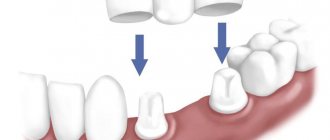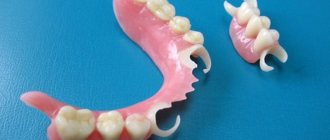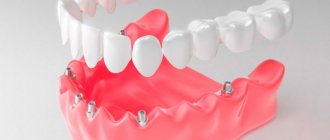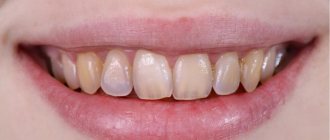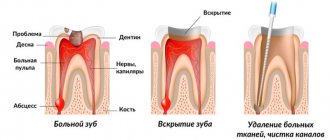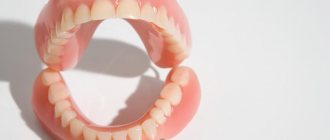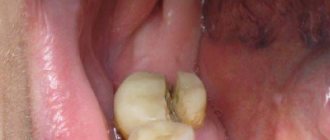Many patients of orthopedic dentists after prosthetics talk about how difficult it was for them to get used to dentures. High-quality permanent artificial teeth and crowns are compact in size and do not cause any discomfort. But with removable ones, problems arise: from unpleasant sensations in the palate and irritating pressure on the gums to constant nausea and even a gag reflex. Each patient experiences the adaptation process in his own way, so it can last only a couple of days, one or two weeks, or several months.
What you need to quickly get used to dentures - recommendations from dentists and important points of adaptation
Article navigation
- The emergence of negative aspects
- Normal conditions
- Pathological conditions
- Recommendations from orthopedists
- Adaptation phases
- How long does it take to get used to
- After a very long period of getting used to
- In case of intolerance
- Wearing rules
- Alternatives
Question for a specialist
Many patients know that getting used to a removable denture is a rather long and complex process.
Even if the choice fell on the most modern and soft orthopedic design, which causes a minimum of discomfort, you will still need to get used to it - both psychologically and physiologically. In today’s article, we’ll look at dentists’ recommendations on how to get used to removable dentures. What rules must be followed so that artificial analogues of natural teeth serve not only as a decoration for a smile, but are also functional, and a person can talk and eat normally without pain.
Digital Computer Dentistry in Kharkov – high quality at the best prices
Today our clinic has a full range of robotic dental production. This allows us to provide the highest quality work for our patients at low prices. We manufacture crowns, bridges and screw-retained prostheses in a digital protocol using CAD/CAM technology. This increases patient comfort and eliminates technical human errors. Therefore, we are constantly introducing digital technologies, promoting digital services and explaining what this means.
4 Best Dental Implant Options That Will Ensure Success
Description of treatment and prices for implantation USA, Israel, Germany.
The appearance of negative aspects after prosthetics
Discomfort after the installation of removable dentures - especially if the structures are full or quite long - occurs in almost every patient. Let us further consider all the negative manifestations that accompany a person immediately after installation. It is also worth immediately dividing discomfort into natural (or normal) and pathological. In the latter case, any attempts to get used to it can lead to complications, so the help of a specialist is required.
Complex on 4 OSSTEM implants with delayed loading - 150,000 rubles.
Complex implantation Osstem (South Korea) with delayed loading after 4-6 months.
Doctor's work guarantee - up to 5 years (under an agreement on the provision of medical services) Call now or order a call
Opening hours: 24 hours a day - seven days a week
As for adaptation and discomfort during prosthetics in dentistry, removable prosthetics will have the most negative manifestations. Fixed structures (veneers, inlays, bridges or single crowns) require virtually no getting used to, because... are made more accurately, have smaller dimensions (replicating the bite) and are attached more reliably.
Kinds
This design includes connected crowns and perfectly performs the task of replacing missing teeth. This technique is used virtually everywhere without any restrictions. The technology is characterized by the following varieties:
- Bridge-like structures are formed from crowns fixed on adjacent teeth and an intermediate section that covers the defect in the void. During chewing movements, the load will be evenly distributed around the perimeter of the bridge. Such prostheses come in several types: all-metal (the simplest and relatively inexpensive), stamped metal crowns with a combined body, metal-ceramics and metal-plastic, plastic-based, adhesive (attached to adjacent teeth with a special glue).
- Implants - a titanium pin is implanted inside the bone tissue, onto which a plastic or metal-ceramic crown is fixed.
- Single crowns are used if the outer part of the incisor is susceptible to destruction, but the root itself has not lost its structure, which is suitable for fixing an orthodontic structure.
- Veneers are ceramic plates that are attached to the front of the tooth.
- Inlays are ceramic elements that are used for large defects, but also, if necessary, to preserve dental tissue, for example, when the chewing incisors are damaged.
The choice of a fixed bridge prosthesis should be recommended by the attending physician, based on the defect of the damaged teeth.
Normal conditions and why they occur
The main reason that you need to get used to a removable denture is its shape and size. Often, orthopedic products contain elements such as massive artificial gums and palate, metal or plastic hooks. They take up a lot of space in the oral cavity and interfere with normal physiology. What manifests itself in the following conditions:
- violation of diction: the free space in the oral cavity is significantly reduced in volume, the tongue is positioned differently during speech - it is often hampered by the additional volume that appears on the palate due to the prosthesis,
- foreign body rejection reflex: salivation increases (because the nerve endings perceive the prosthesis as food). There may also be a gag reflex and a desire to quickly remove the structure from the mouth,
- dry mouth: occurs due to blockage of the ducts of the salivary glands,
- discomfort in the gum area: burning, severe pressure. Occurs when an orthotic device has metal parts, or when the structure moves while eating. The cause may also be the irritating effect of plastic or metal,
- changes in muscles and joint function: weak, nagging muscle and joint pain may occur. New dentures allow you to chew food with renewed vigor (and the muscular frame is already unaccustomed to such efforts in the absence of teeth for a long time),
- food “loses” its taste: the lack of taste is due to the fact that the device blocks the receptors located on the mucous membrane,
- psychological discomfort: the installation of prosthetic devices is often associated with a change in behavior - difficulty communicating, for example. After all, people around you will definitely notice the changes that have occurred in your appearance. In addition, the patient himself will understand that although he has new teeth in his mouth, they still belong to the category of “false jaws.”
REPROSTHETICS WITH ACRYLIC PROSTHETICS - RUB 200,000.
Re-prosthetics with an acrylic bridge on a metal frame (all included) up to 12 units.
Save RUR 30,000. Call now or request a call
Despite the fact that all these difficulties are natural and completely avoidable, the patient will need a certain amount of willpower to follow all the doctor’s recommendations. Many orthopedists advise not to remove dentures at night during the first month of wearing them, so that adaptation occurs as easily and quickly as possible. And even if the design is comfortable and does not cause discomfort, you still need to visit the doctor according to the schedule - after all, patients with a high pain threshold may not notice that the device needs to be adjusted.
Restoring diction
Impaired diction and a lisp after prosthetics occur in 99% of cases. Some recommendations will help you cope with this. Firstly, for a month after prosthetics, it is recommended to leave the structure in the mouth overnight. Secondly, it is important to do special exercises daily to develop speech.
At first, the prosthesis will greatly interfere with everything; it will be difficult to talk with it, laugh, or open your mouth too much.
What should be done to restore normal diction after prosthetics:
- Read more out loud;
- talk a lot;
- Try to clearly pronounce the sounds s, z, c, t, d, ch, sh, sch;
- Speak tongue twisters.
For most people, following these recommendations, speech is restored within a week. If the patient went without teeth for a long time before making the prosthesis, this period is extended.
Pathological conditions and the need for medical care
The main pathological symptom is severe pain or burning under (or around) the orthopedic structure, which does not go away 1-2 weeks after installation. The pain may be accompanied by inflammation of the mucous membrane - ulcers, redness, bleeding. Such manifestations may occur due to an allergy to the material1 or due to poor manufacturing of the device.
It is also not the mucous membrane that may hurt, but the supporting teeth, if they were poorly depulped or not depulped at all. Pathological signs include severe pain in the jaw joint, noticeable instability of the structure - which is also considered an error in the manufacture of the devices. In all of the above situations, you should definitely contact your dentist as soon as possible.
Indications and contraindications
Indications for installing a permanent bridge structure are:
- defects and abnormal processes of various nature (caries, damage, etc.);
- visual defects, if they cannot be removed by other means;
- defects in the dentition;
- replacement of previously poorly made bridge structures.
Let's figure out which removable dentures are better
Contraindications for the installation of this type of prosthesis include:
- grinding;
- pathological bite;
- periodontal disease in severe stages;
- abrasion of hard tissues.
Recommendations from orthopedists for quick adaptation
How to get used to dentures? Every patient must have asked this question. According to estimates from practicing orthopedists, for 40% of patients it comes as a complete surprise when they learn about the need for adaptation. Of course, people with small removable segments practically do not need to get used to it, but patients with complete orthopedic devices (or those replacing more than half of the dentition) will have to go through an adaptation period. To get used to removable dentures as best as possible, you should adhere to the following recommendations from your dentist.
BEST REMOVABLE DENTURE - 20,000 rub.
All manipulations for the manufacture, installation and fitting of the prosthesis, including impressions, are included.
Save RUB 10,000! >> Call now or request a call
Opening hours: 24 hours a day - seven days a week
Recommendations for restoring diction - exercises and gymnastics
How to properly adapt speech when wearing removable prosthetic structures? In general, normal speech production returns within a few days or weeks, depending on the shape, type and thickness of the orthopedic solution. In the first few days after installation of the structure and until complete adaptation, it is recommended to talk more and read aloud - prose or poetry. This will help you “learn” to pronounce sounds correctly again.
For example, one of the exercises is that you need to quietly and measuredly pronounce the numbers from 1 to 10, and in reverse order. Then you can raise your voice and speed up the pace. Classes should be held 4-5 times a day for 10-15 minutes. To quickly get used to it, you can also do lip gymnastics, say tongue twisters, after putting a few lollipops in your mouth (it’s better if they are sugar-free).
How to relieve pain when eating
To reduce discomfort and reduce pressure on the gums, you need to be careful when chewing foods. In the first 1-3 days, preference should be given to soft and non-dry foods (boiled, mashed into purees). Then you can, gradually increasing the chewing load, switch to a denser consistency, but it is better to avoid chewing chunks of meat or biting off apples for 2-3 weeks. To be able to eat such foods normally, you should cut them into small pieces.
How to eliminate chafing, inflammation of the gums and palate
What to do if removable dentures rub, gums become inflamed, and ulcers appear on the mucous membranes? Here, the best option would be to go to the clinic to adjust the prosthesis or identify allergies. It is likely that the dentist will prescribe the use of fixing creams, which additionally create a kind of shock-absorbing “pillow” that prevents the plastic base from injuring the delicate mucous membrane. Dental gels with an anesthetic and antiseptic/antibacterial effect can be used to relieve pain and inflammation. Some patients benefit from rinsing the mouth with infusions of chamomile or sage.
It is important to tell your doctor about all the problems you encountered after dental prosthetics - in this case, the dentist will be able to eliminate them and make the design as comfortable as possible.
How to restore normal salivation
When the mucous membranes dry out, you need to drink liquid more often - ordinary water without gas. You can not immediately swallow the liquid, but hold it in your mouth for a while. To normalize salivation (if it increases), it is recommended to rinse or mouth baths with saline solution (1 tablespoon per 1 liter of water).
What to do if you feel nauseous
Nausea (or a gag reflex) may appear even at the stage of fitting and just installation of an orthopedic device. To relieve unpleasant symptoms, you need to try to inhale and exhale only through your nose. This way the adaptation process will end faster.
Don't know what type of prosthetics to choose?
We will help in the selection, advise where to read more information and compare types of prosthetics.
Consultation with an orthopedic doctor in Moscow clinics is free! Call now or request a call
Working hours: from 9:00 to 21:00 - seven days a week
How to start tasting food
Here you need to understand that in fact the taste of the food has not changed at all - it remains the same as it was. But the blocking of taste buds by prosthetic elements does not allow a person to fully enjoy their favorite dishes. Therefore, you need to get used to the changes that have occurred and not try to enhance the taste of food with food additives, pepper, etc. Each piece should be chewed thoroughly, and after 2-3 weeks the taste sensations will return to normal.
Rules for quality fixation
If a person is afraid that the denture will fall out during communication or while eating in a public place, then it is recommended to use adhesives or gels for fixation. High-quality products, such as Protefix or Fittydent, have a long-lasting effect and provide fixation for 8-12 hours.
Restoring psychological comfort
Psychological adaptation occurs much faster if the design does not cause severe discomfort. Therefore, the selection of an orthopedic device should be approached as carefully as possible (even before production) and listen to the opinion of the dentist, who will advise the optimal solution. At the preparation stage, it is necessary to find mutual understanding with the orthopedist, who must objectively explain the correctness of choosing a particular design.
What diet should you follow?
A lot depends on the original condition of the tooth to be restored. So, if the root is strong, approximately half of the tissues of the coronal part are preserved, and the prosthesis itself is installed correctly and professionally, there are no obvious restrictions in terms of load. Stump tabs, which are also used to strengthen the root system, fit very tightly, hold securely and do not require any special changes in nutrition. But if, for example, prosthetics were performed on a pin, the chewing pressure on the tooth must be reduced, since it can lead to displacement of the pin, and subsequently the crown.
In general, recommendations for any type of prosthetics from a nutritional point of view would be as follows:
- limiting the consumption of drinks high in caffeine (tea, coffee) and coloring pigments (wine, beets), especially if you have plastic and metal-plastic crowns that absorb dyes from food and drinks,
- Food that is too cold or too hot should be eaten with great caution - it can lead to cracks and chips of materials, and disruption of their adhesion (fixation). It is also impossible, for example, to immediately drink hot tea after cold ice cream - sudden temperature changes can again provoke the formation of cracks and destruction of dentures, weaken the effect of the fixing adhesive,
- Despite the fairly high strength of crowns and inlays, you need to protect them from excessive loads - it is better to first cut solid food into small pieces,
- teeth with crowns should not be used to open the shells of nuts, such as pistachios,
- If you have dentures, it is recommended to avoid viscous and stringy foods, namely chewing gum and toffees, which can stick to crowns or inlays, and with excessive load and gradual deterioration of the fixation of the prosthesis can lead to its loss.
First of all, crowns that have an external coating that can break off need to be protected from mechanical loads - made of metal-plastic, metal-ceramic or zirconium coated with ceramic.
Phases of adaptation to prostheses
The entire period of habituation can be divided into several periods or phases:
- irritation phase: begins on the day of installation of the orthopedic structure. There is increased patient attention to the prosthesis (constant touching with the tongue), increased salivation, diction changes sharply, a feeling of nausea and problems with chewing food arise,
- partial inhibition phase: occurs from the 1st to the 5th day of wearing “artificial teeth”. Salivation gradually normalizes, diction is restored, and nausea disappears. A person gradually switches to tougher foods,
- full inhibition phase: lasts from 6 to 34 days. Characterized by maximum restoration of chewing function. Habituation reaches the point where a person feels uncomfortable when the prosthesis is not in the mouth.
Service life
A fixed bridge structure is characterized by a service life of 5 to 15 years or more. The length of time a bridge can last depends on various circumstances:
- quality and quantity of supporting teeth;
- condition ;
- length of the bridge;
- distribution of load on the bridge during chewing.
Pros and cons of a bar prosthesis
After 5 years of using it, you need to focus on:
- mobility of the structure;
- the condition of the gums under the supporting teeth;
- condition of the gums under the artificial teeth of the prosthesis: redness, bleeding;
- the condition of the gums between teeth and crowns;
It is permissible to take an x-ray so that a specialist can assess the condition of the teeth and periodontal tissues.
Subject to hygienic oral care and regular examinations, the operation of the bridge structure will last up to 15 years or more.
How long does it take to get used to different types of prostheses?
How long does it take to get used to removable dentures? How quickly a person gets used to it depends on the flexibility of the construction material, the number of hooks (clasps), the thickness and area of the product. How long does it take to get used to removable dentures? To clarify this issue, consider the data below:
- acrylic: has medium hardness, is made of modern plastics, has a voluminous artificial palate (for the upper jaw). It may cause chafing, does not adhere well to the gums, and allergic reactions are also possible. The period of adaptation in patients with complete edentia is 2-5 months.
- clasp: has compact dimensions and a small palatal bridge, which reduces the likelihood of nausea. However, the presence of metal hooks or attachments can cause rubbing or allergies, or a metallic taste in the mouth. Metal hooks provide a stable fixation, but are noticeable during a conversation (if installed in the frontal area), and this causes psychological discomfort. Addiction is quick and takes 2-4 weeks,
- nylon: flexible and, at the same time, well fixed. It extremely rarely causes allergies. Therefore, addiction takes less than 1 month. But a significant drawback of nylon products is their fragility - they quickly stretch and lose their fixation,
- Acry-free: made of hypoallergenic plastic (including clasps), quite rigid. They also get used to this type in 3-4 weeks, but it will take about 3 months to adapt to a full model for the entire jaw - especially if the patient has been missing teeth for a long time,
- Quattro Ti: “Quadrotti” is often called an analogue of the “clasp” solution, because they have a palatal bridge (but made of a special plastic material, not metal). Quite elastic, perfectly fixed, and the unique material has low toxicity. Getting used to it takes 1-2 weeks.
Patient reviews
It took me a long time to get used to the plate prosthesis on the upper jaw. The worst thing for me was feeling the constant fear that it would accidentally fall out. Then a friend advised me to stop suffering and buy fixing glue at the pharmacy. It really helped, I gained more self-confidence. With this glue I laugh calmly and eat without problems. I read reviews that dentures have a bad effect on the mucous membrane, but I didn’t notice anything like that.
Olga, 58 years old
My father was fitted with a removable denture 2 years ago. He got used to it for about three weeks, after which he said that his teeth were already like his own. However, a few months later there was a breakdown, and the prosthesis was repaired, after which the problems began. My father’s gums began to become inflamed, he began to have bad breath, and began to experience pain when chewing. The dentist said it was prosthetic stomatitis and prescribed gels and tablets. After starting treatment, it took another month for everything to return to normal.
Ilya, 32 years old
I have had a removable partial denture on my lower jaw for 5 months now.
The first weeks were, of course, very strange to eat and talk. I tried to follow all the doctor’s recommendations, but then it seemed that I would never get used to him. Now there are no problems anymore. Stanislav, 44 years old
What to do if you have been addicted for a very long time
The concept of “long-term addiction” can be individual for each person. Some people think that 2 weeks of adaptation is a long time. And some people can’t get used to it after six months and think that “everything is fine.” In general, everyone gets used to it over time (unless, of course, there is intolerance - but more on that later). The maximum adaptation “bar” is just a 6-month wearing period. Moreover, the design really needs to be worn constantly, and not occasionally.
If it is difficult to adapt, then remember all the dentist’s recommendations and strictly follow them - perhaps something has been forgotten over time, then the general recommendations of orthopedists will come to the rescue.
It is important to understand that the patient may well confuse the symptoms of addiction to orthopedic devices with complications or the need to reline the device. You also need to know in advance that any, even the most modern, removable products do not involve the jaw bone in the same way as your own teeth (or rather, their roots) or implants do. Therefore, bone tissue atrophy does not disappear when wearing removable models, but only progresses. Because of this, the relief of the bone and gums changes (they sag, decrease in height and width). That is, the shape of the prosthesis no longer corresponds to the state of the support. The product does not fit well, rubs, and often falls out. Therefore, you need to regularly visit your dentist so that the specialist will try to correct the situation.
Zirconium dioxide crown on an implant for the whole 70,000 rubles.
OSSTEM implant (South Korea), individual zirconium abutment, gum former, impression taking.
Creation of a Prettau zirconium crown using 3D modeling technology. Consultation with 2 doctors: an orthopedist and an implantologist for free! Call now or request a call
Opening hours: 24 hours a day - seven days a week
Is it possible to smoke if you have dentures?
There is no direct ban on smoking, but you need to understand that nicotine leads to the formation of a large amount of plaque - both on real and artificial teeth. It is difficult to remove; the gums also suffer because of it - they do not receive enough nutrients, atrophy and expose the tooth roots. If you can’t quit smoking, then try to at least reduce the number of cigarettes you consume to a minimum, at the same time improve hygiene at home, and also visit a doctor every 2-3 months for comprehensive oral hygiene.
What to do if you are intolerant
According to statistics, about 7-8% of people cannot adapt to wearing orthopedic products due to intolerance. It occurs due to severe rubbing, allergies to plastic or metal. The reason is the individual characteristics of the body, unstable psycho-emotional states or immunity weakened by frequent illnesses, as well as manufacturing errors. There is only one way out - to seriously correct the product or make a new one, from higher quality raw materials or from a more experienced dentist (dental technician). Intolerance is manifested by severe symptoms:
- swelling and redness of the gums/palate,
- severe joint pain: it may also be difficult to open and close your mouth,
- metal or plastic taste
- severe itching or burning in the gums.
“I installed acrylic “pullers” on the top and bottom 5 days ago, since there were practically no teeth left - there was only one tooth each on the top and bottom rows. I still can’t get used to it at all. I can only wear it a little and then take it off faster. It is impossible to eat in them at all; I cannot taste the food. While chewing, my teeth somehow knock against each other, and I can’t figure out where the piece of food was. And chewing is very painful, there is a lot of pressure on the gums. It’s also impossible to speak normally in them; the accent has a “lisp.” In general, I’m already tired of all this. As a result, I went to another doctor who made me normal dentures - it became much more comfortable!”
Dmitry P., review from the dental portal gidpozubam.ru
Selection and cost of zirconium crowns
These products can withstand stress and still look like your own teeth. Therefore, they can be used for any areas - the anterior and chewing areas, both on the upper and lower jaw.
Zirconium is widely used to restore tissue damaged by caries or trauma, for example, on a stump inlay. This is also an excellent option for prosthetics on implants. The price tag for installing a crown on the product itself, together with a temporary prosthesis, starts from 14,080 rubles according to the promotion.
For what situations is zirconium not suitable?
- Bridges with more than 2 teeth. Metal ceramics are more suitable here.
- Bridges with end defects - in these cases it is also better to prefer ceramics on metal.
How should patients who have zirconium dental crowns installed behave?
Give yourself time to get used to it
. The volume of the tooth has changed and it is necessary to adapt. Diction may change, and sometimes unusual sensations arise when chewing. Practice, and in a couple of days everything will be back to normal.
Treat with care, but without fanaticism
. That is, you don’t need a particularly strict diet, but you still shouldn’t crack nuts and other extremely hard foods with new zirconium crowns.
Take care as usual
. In general, the procedure is no different from caring for natural teeth. Use floss and rinse your mouth after eating. The only caveat is that if the majority of zirconium crowns are in your mouth, when choosing a paste, focus more on the condition of your gums. That is, pastes with calcium and fluoride will be irrelevant.
What can we offer the patient at Implant Lab?
We save where others delete
. If there is even the slightest chance that the tooth can be saved, restored and covered with a dental crown and then used for years, we will do it.
We set where others fail
. The main thing in the work is experience, scrupulousness and accuracy, as well as aesthetic taste. Our doctors and dental technicians have all these qualities.
We make procedures comfortable where others make you nervous
. We have a personal treatment coordinator who handles all organizational issues. With it, you always know who to come to and when and don’t waste time waiting and making an appointment.
We reduce prices where others do not meet halfway
. As you can see, everything is quite affordable for a client with an average income. Plus, credit programs and installment plans, as well as promotions, allow you to install best-in-class zirconium crowns and enjoy your smile.
Wearing and hygiene rules
To make the habituation process easier and faster, you need to ensure proper wearing and care of artificial teeth. As already noted, in the first month it is better to leave them in the mouth overnight. You need to remove the device from your mouth only for hygiene purposes, which consists of the following points:
- After each meal, the structure should be removed and washed,
- for fixation, use high-quality products that have not expired,
- Clean the product morning and evening: using a soft toothbrush and toothpaste without scratching particles,
- sterilize the product 1-2 times a week: for this you should use specialized solutions or tablets (they are sold in pharmacies).
Is it possible to carry out professional hygiene with crowns?
Both teeth and any dentures require high-quality hygiene. Once or twice a year, have your teeth cleaned with an ultrasound. But Air Flow is prohibited in the presence of multiple crowns, since the drug contains abrasive particles that can damage the smooth surface of the dentures. In such a situation, you should definitely warn the doctor about the presence of crowns or bridges - if there are few of them, you can simply bypass them and carry out Air Flow cleaning in another area.
What are the alternatives?
Dental implantation is considered the optimal option for dental prosthetics - it does not require habituation and ideally restores the aesthetics of a smile and chewing function. Here, single crowns, bridges or complete dentures with a minimum amount of gum are used as the supragingival part of the prosthesis (depending on how many teeth you are missing). Therefore, they take up very little space in the oral cavity and are not perceived by the body as a foreign object.
Another advantage of implantation is the fact that in the process of chewing food, the load is transferred not to the gum mucosa, but to the bone (which is a physiological method). That is, atrophy does not occur here, or it does occur, but on a miniscule scale. It turns out that the prosthetic structure on implants does not need to be adjusted or repositioned. The implants are also firmly fixed in the jaw (for decades), which will prevent the orthopedic device from suddenly falling out of the mouth.
- Napreeva A.V., experimental clinical study “The influence of denture materials on organs, tissues and environments of the body” / Omsk State Medical Academy - Omsk, 1996. - 16 p.
Author: Dulgarov Zh. G. (Thank you for your help in writing the article and the information provided)
Structure
Fixed bridges are firmly attached and fully replace lost teeth. They allow the patient to wear them for a long time without removing them. Often, a fixed bridge structure is directly installed for patients who do not have several teeth in one row.
A bridge prosthesis has two points of support as 2 adjacent teeth, and the structure itself is located in the middle of them. During the chewing process, the load will be distributed to the supporting teeth.
Such a prosthesis includes the following elements, which are one whole: artificial crowns for abutment teeth and artificial teeth that replace missing ones. They are also called the rinsing part, that is, they are not on the gum, but between it and the teeth; there is a certain gap that is necessary for hygiene procedures (elimination of food residues).
Caring for removable dentures
Although a removable denture is an artificial structure, it still requires careful and high-quality care, because in fact, after installation, it becomes part of your body. Proper care of removable dentures guarantees comfortable wearing of the structure and its durability.
There are rules that must be followed for those who want to keep their dentures for a long time.
Rules for caring for removable dentures
After each meal, try to remove the denture to rinse it under running water. This not only ensures the comfort of wearing the denture (small particles of food remaining under the structure are very disturbing), but also guarantees the protection of the gums from the effects of pathogenic bacteria. Those pieces of food that remain under dentures are a breeding ground for microbes that can cause gum disease.
Cleaning a removable denture should be done with a soft-bristled toothbrush so as not to damage the integrity of the structure. When cleaning, special attention should be paid to: the part that is in direct contact with the gum, areas near the salivary gland canals, the front part of the lower jaw dentures and the side part of the upper jaw denture.
You can use regular toothpastes to clean your dentures. But try not to clean your dentures with whitening toothpaste. Such pastes contain strong abrasive substances that can damage the material of the structure.
Before going to bed, after the adaptation period has passed, the denture should either be left in the mouth or removed. You should clean your denture not only after each meal, but also before going to bed. It is necessary to store dentures at night in purified water (even boiled water will do) or a special composition that you can buy in pharmacies.
In case of breathing problems, sleep disorders, snoring and teeth grinding, dentures must be removed at night. If you are absolutely sure that you have one of the listed diseases, tell your dentist about it at your appointment. You will be recommended a treatment that will relieve you of your sleep problems. If you are concerned about your prosthesis or are just about to start prosthetics, we suggest you contact our Dentistry clinic on Shchelkovskaya Diamed. Convenient location, attentive doctors, and extensive experience in working with removable dentures guarantee you the accuracy of the work performed and the comfort of wearing a removable denture. You can sign up for the clinic by calling 8 or using the online registration form.
Eating with removable dentures
Caring for removable dentures involves regular disinfection. The prosthesis is placed in water in which a special disinfectant capsule is dissolved. It is enough to place the prosthesis in the prepared solution for only fifteen minutes.
To maintain the beautiful appearance of the prosthesis for as long as possible, try to consume less products with dyes, as well as tea, coffee, wine and other alcohol. Smoking also significantly increases the likelihood of darkening and discoloration of the denture. Avoid getting sticky food (taffy, chewing gum) on your dentures. Crackers, hard nuts, ice - all this should not be chewed if you do not want the prosthesis or artificial tooth to break.
Soreness
Most often, patients complain of pain and pressure on soft tissues. This phenomenon is observed when soft tissues are unaccustomed to stress and begin to hurt not only when chewing, but also at other times. Many people start taking painkillers as the only way to alleviate the condition. In addition to medications, which are needed only at first, it is recommended to change the diet and eliminate solid foods. It takes about a month to adapt, after which the pain stops bothering you. If the discomfort lasts longer, you should definitely see a doctor.
One option to reduce pain is gum massage. To do this, follow these simple steps:
- wash your hands with any soap with antibacterial properties;
- the prosthesis is removed, the gums should be stroked with gentle circular movements, gradually touching the inflamed area;
- the pressure gradually increases, you need to start making vertical movements.
The duration of exposure is three to four minutes, after which the pain decreases. It is recommended to do massage not only during the period of adaptation, but also constantly, improving blood circulation in the tissues, eliminating the risks of developing inflammation.
